Gravity is a force that attracts objects towards the center of the Earth or towards any other massive physical body. It is a fundamental force of nature that acts on all objects with mass. Gravity plays a significant role in shaping the structure of the universe and governing the motion of celestial bodies. For example, it keeps planets in their stable orbits around the Sun. The strength of gravity depends on the mass of the objects involved, with larger objects exerting a stronger gravitational pull.
Examples
Water droplet

During the rainy season, water droplets can be observed hanging on the edges of leaves, ready to fall. This phenomenon demonstrates the force of gravity in action. It is the force of gravity that pulls these water droplets downward, directing them towards the ground.
Slipped coin

Visualize yourself holding a handful of coins in your hand. As you gradually release your grip, some of the coins slip and fall downward. This simple yet illustrative scenario perfectly captures the force of gravity in action. Gravity, the fundamental force that attracts objects towards the Earth, is the reason behind the coins descending from your hand.
Tennis ball

Imagine playing with a tennis ball and tossing it into the air. It becomes evident that gravity is at work as the ball is always pulled downward. Regardless of the height to which it is thrown, the ball always descends towards the ground. This behavior of the tennis ball demonstrates the presence of gravity.
Tap water
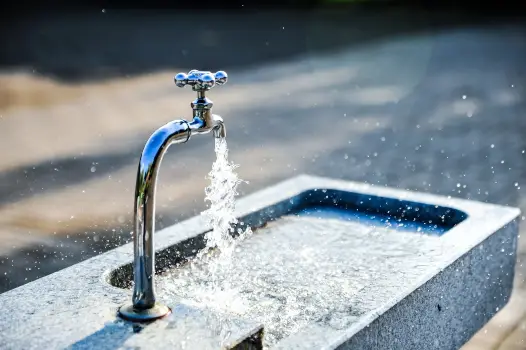
When a tap is opened, water flows out due to the pressure created by the water supply system. As water flows out of the tap, it is pulled downwards towards the ground by gravity, which is the natural force that pulls all objects towards the center of the Earth. Gravity acts on everything, including water, causing it to move downwards in a straight line. So, when water is seen falling from a tap, it’s because gravity is pulling it downwards towards the Earth.
Waterfall

When observing a waterfall, one can witness the water gracefully descending downwards. This downward motion of the water is attributed to the force of gravity. Irrespective of the quantity of water flowing from the waterfall, it consistently moves downward, driven by the pull of gravity.
Flying kite

During the festival of Makar Sankranti, which involves flying kites, it is common to witness kites descending gracefully to the ground when they become detached from the thread. This phenomenon serves as a visible demonstration of the force of gravity at work.
Dropped ball
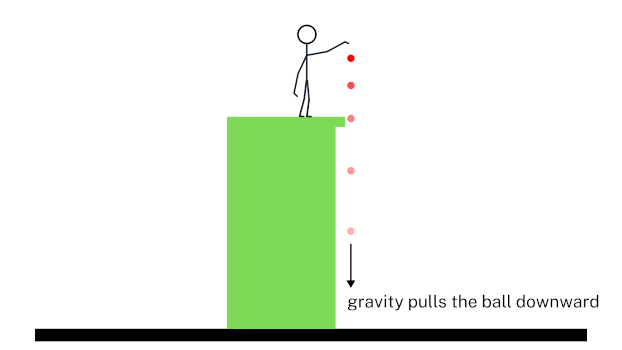
When a ball is released from a certain height, it consistently moves downward towards the ground. This observation highlights the effect of gravity. Regardless of the ball’s weight, whether it is heavy or light, or the height from which it is dropped, it always experiences the downward pull of gravity.
Swimming
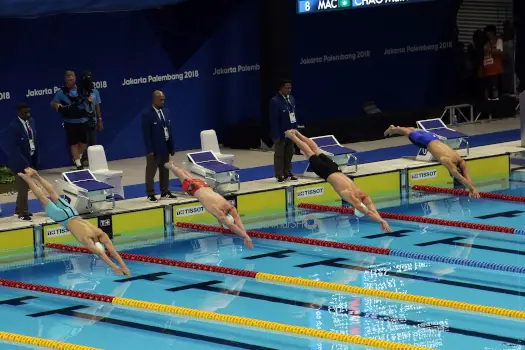
When swimmers jump into a swimming pool, they experience the force of gravity pulling them downwards. Simultaneously, the upward buoyant force exerted by the water counteracts the force of gravity, resulting in the swimmers being pushed upwards. The interplay between gravity and buoyancy plays a crucial role in determining the behavior of objects submerged in a fluid medium, such as water.
Apple
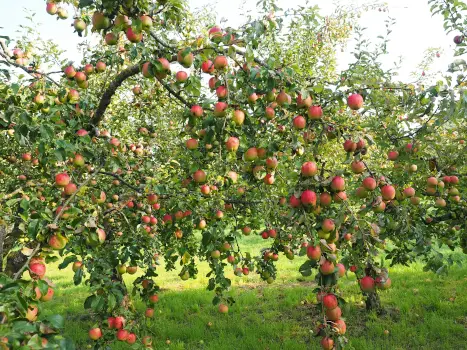
Fruits growing on trees and naturally falling to the ground when ripe is a clear demonstration of gravity in action. The force of gravity, discovered by Sir Isaac Newton, is responsible for pulling the apple and other fruits downwards from the tree and causing them to land on the ground. This fundamental force of nature acts on all objects with mass, like the apple, and attracts them towards the center of the Earth.
Water sprinkler

When a water sprinkler is activated in gardens and farms, the water released from the sprinkler falls directly to the ground. This downward motion of the water is a clear demonstration of gravity in action.
Debris flow
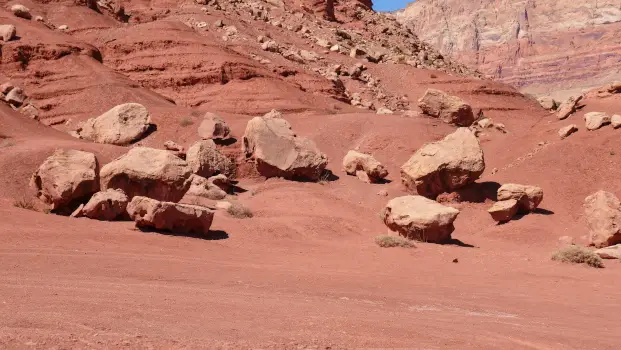
When a landslide occurs, stones and other small debris start rolling down the hill. This downward movement of the debris is a clear demonstration of gravity in action. Gravity exerts a force on the stones and other small debris, causing them to move downward along the slope.
Floating paper

If a bundle of paper is tossed up into the air, the papers will separate and remain suspended for a while before eventually falling downward onto the floor. This downward motion of the papers clearly demonstrates the presence of gravity. Gravity pulls the papers towards the floor, causing them to descend from their elevated position in the air.
Stone

Throwing a small stone up into the air on a beach is a clear example of gravity in action. The stone will naturally descend back towards the beach. It’s the force of gravity that pulls the stone downwards and guides its return to the Earth’s surface.
Shower water

During a shower in the bathroom, the water released from the shower head can be observed gracefully falling to the floor. This phenomenon serves as a clear demonstration of the force of gravity. It is gravity that effortlessly pulls the water downwards, creating a gentle flow from the shower head to the floor.
Equation
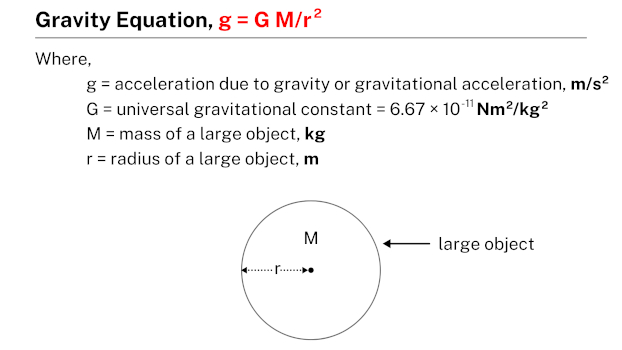
The gravity equation, g = G M/r2, states that the acceleration due to gravity (g) is equal to the product of the universal gravitational constant (G) and the mass (M) of the celestial body, divided by the square of the distance between the centers of mass (r). This equation enables the calculation of gravitational acceleration between two objects, utilizing their masses and the distance separating them. It is a fundamental equation in physics that helps in understanding the force of gravity acting between celestial bodies.
Practice problems
Problem #1
Calculate the value of gravitational acceleration on the surface of the Earth, given that the mass of the Earth is 5.972 × 1024 kg and the radius of the Earth is 6.378 × 103 km. Consider the universal gravitational constant as G = 6.67 × 10-11 Nm2/kg2.
Solution
Given data:
- Gravitational acceleration on the surface of the Earth, g = ?
- Mass of the Earth, M = 5.972 × 1024 kg
- Radius of the Earth, r = 6.378 × 103 km = 6.378 × 106 m
- Universal gravitational constant, G = 6.67 × 10-11 Nm2/kg2
Applying the formula:
- g = G M/r2
- g = (6.67 × 10-11 × 5.972 × 1024)/(6.378 × 106)2
- g = (39.9 × 1013)/(40.7 × 1012)
- g = 0.9803 × 10
- g = 9.81 m/s2
Therefore, the gravitational acceleration on the surface of the Earth is 9.81 m/s2.
Problem #2
If the mass of Jupiter is 1.898 × 1027 kg and the radius of Jupiter is 69.911 × 103 km, calculate the value of gravitational acceleration on the surface of Jupiter. Take the value of the universal gravitational constant as G = 6.67 × 10-11 Nm2/kg2.
Solution
Given data:
- Mass of the Jupiter, M = 1.898 × 1027 kg
- Radius of the Jupiter, r = 69.911 × 103 km = 69.911 × 106 m
- Gravitational acceleration on the surface of the Jupiter, g = ?
- Universal gravitational constant, G = 6.67 × 10-11 Nm2/kg2
Applying the formula:
- g = G M/r2
- g = (6.67 × 10-11 × 1.898 × 1027)/(69.911 × 106)2
- g = (12.7 × 1016)/(4887.6 × 1012)
- g = 0.002598 × 104
- g = 25.98 m/s2
Therefore, the gravitational acceleration on the surface of Jupiter is 25.98 m/s2.
Problem #3
What is the value of gravitational acceleration on the surface of Mars, given that the mass of Mars is 6.39 × 1023 kg and the radius of Mars is 3.3895 × 103 km? Consider the universal gravitational constant as G = 6.67 × 10-11 Nm2/kg2.
Solution
Given data:
- Gravitational acceleration on the surface of Mars, g = ?
- Mass of the Mars, M = 6.39 × 1023 kg
- Radius of the Mars, r = 3.3895 × 103 km = 3.3895 × 106 m
- Universal gravitational constant, G = 6.67 × 10-11 Nm2/kg2
Applying the formula:
- g = G M/r2
- g = (6.67 × 10-11 × 6.39 × 1023)/(3.3895 × 106)2
- g = (42.7 × 1012)/(11.5 × 1012)
- g = 3.71 m/s2
Therefore, the gravitational acceleration on the surface of Mars is 3.71 m/s2.
Problem #4
Calculate the value of gravitational acceleration on the surface of the Moon, with the mass of the Moon being 7.342 × 1022 kg and the radius of the Moon being 1.7371 × 103 km. Consider the universal gravitational constant as G = 6.67 × 10-11 Nm2/kg2.
Solution
Given data:
- Gravitational acceleration on the surface of the Moon, g = ?
- Mass of the Moon, M = 7.342 × 1022 kg
- Radius of the Moon, r = 1.7371 × 103 km = 1.7371 × 106 m
- Universal gravitational constant, G = 6.67 × 10-11 Nm2/kg2
Applying the formula:
- g = G M/r2
- g = (6.67 × 10-11 × 7.342 × 1022)/(1.7371 × 106)2
- g = (48.9 × 1011)/(3 × 1012)
- g = 16.3 × 10-1
- g = 1.63 m/s2
Therefore, the gravitational acceleration on the surface of the Moon is 1.63 m/s2.
Related
More topics
- Air resistance examples
- Gravity examples
- Inertia examples
- Acceleration examples
- Momentum examples
- Mass examples
- Velocity examples
- Friction examples
- Frame of reference examples
Image credit
- The stock photos used in this post are sourced from platforms like Pexels, Pixabay, Canva, etc. Due to the age of the images, their specific origins remain unknown.
External links
- Examples of Gravity – YourDictionary
- Gravity Examples – SoftSchools.com
- 20 Amazing Examples of Gravitational Force in Our Daily Life – SolveQuestions
- What Is Gravity? – NASA Space Place
- Gravitational Energy – Solar Schools
- Gravitational Force | Definition, Formula & Examples – Study.com
- Gravity – Wikipedia
- Gravity Concepts and Applications – HyperPhysics Concepts
- What are examples of gravity force? – Quora
- Gravity – Maths Is Fun
- Gravity and satellite motion – Science Learning Hub
- Gravity Definition & Meaning – Merriam-Webster
- What is gravity? – Space.com
- Gravity | Definition, Physics, & Facts – Britannica
Deep
Learnool.com was founded by Deep Rana, who is a mechanical engineer by profession and a blogger by passion. He has a good conceptual knowledge on different educational topics and he provides the same on this website. He loves to learn something new everyday and believes that the best utilization of free time is developing a new skill.
